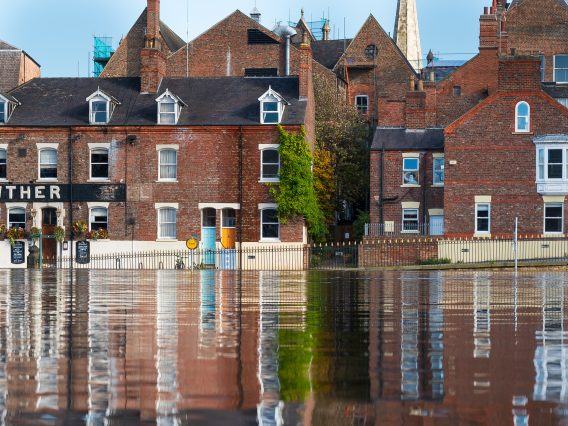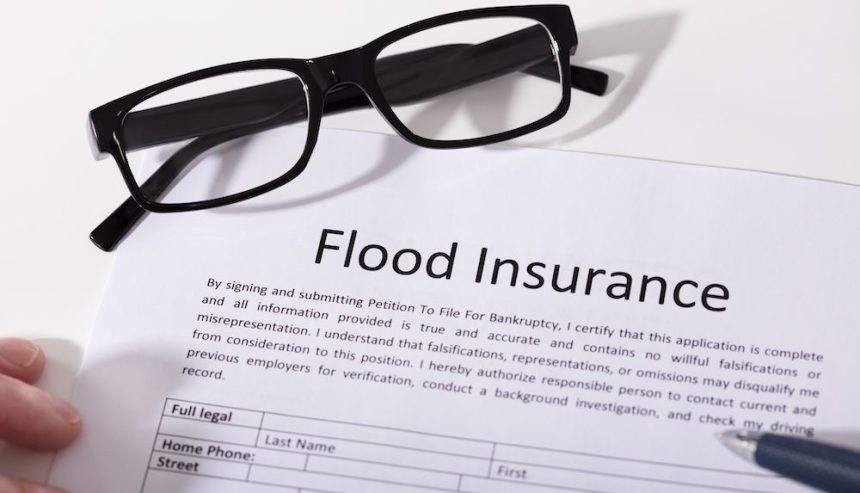Flood insurance for high-risk properties is essential for homeowners in flood-prone areas, as standard homeowners insurance does not cover flood damage. Because of their history of flooding, high-risk properties often require specialized coverage from the National Flood Insurance Program (NFIP) or private insurers. The FEMA-managed NFIP covers both personal property and structural damage, but its coverage is limited.
Private flood insurance can offer higher coverage limits, shorter waiting periods, and additional benefits like temporary living expenses for homeowners who want more protection. The designation of a flood zone, elevation, and previous claims all impact the cost of insurance premiums for high-risk properties. Premiums can be reduced by taking preventative measures like elevating the house, installing flood barriers, and improving drainage.
Overview the Flood Insurance for High-Risk Properties
Flooding is one of the most destructive natural disasters, causing significant damage to properties, businesses, and infrastructure. For high-risk properties—those situated in flood-prone areas—flood insurance is a vital safeguard.

While many homeowners assume their standard home insurance policy will cover flood damage, this is typically not the case. Understanding how flood insurance works, its necessity for high-risk properties, and the coverage options available is critical for homeowners, business owners, and property investors in flood-prone regions.
Understanding Flood Risk Zones
Flood insurance is essential for properties located in designated flood zones. The Federal Emergency Management Agency (FEMA) maps flood zones and categorizes them based on the level of risk. High-risk flood zones, often labeled as Special Flood Hazard Areas (SFHAs), are areas with a 1% or greater annual chance of flooding, usually referred to as the “100-year floodplain.”
Lenders require properties in these zones to carry flood insurance, and the risks in these areas are considerably higher than in low—or moderate-risk zones.
National Flood Insurance Program (NFIP)
The National Flood Insurance Program (NFIP) is a government-backed initiative that provides flood insurance to property owners across the United States. The NFIP was created to reduce the financial impact of flood damage by making flood insurance more accessible.

The program is designed to provide affordable flood coverage, though it has specific limits on the amount of coverage it offers. Homeowners in high-risk areas are encouraged to participate in the NFIP, as it is often the only option available for flood insurance.
Private Flood Insurance Providers
While the NFIP is a widely used flood insurance option, private insurance companies also offer flood insurance policies. Private flood insurance policies may provide more extensive coverage, higher coverage limits, and more flexibility than the NFIP.
These private providers may be appealing to property owners who need coverage beyond the limits of the NFIP or who want policies with fewer restrictions. Additionally, some private insurers offer customized policies with faster claims processing or more comprehensive coverage for specific types of damage, like debris removal.
What Flood Insurance Covers for High-Risk Properties
Flood insurance for high-risk properties typically includes two main components: building property coverage and contents property coverage.
- Building Property Coverage: This covers the structure of the home or building, including walls, foundation, windows, and essential utilities. It also covers systems like plumbing and electrical wiring.
- Contents Property Coverage: This covers the belongings inside the property, including furniture, electronics, clothing, and other personal possessions. For high-risk properties, it’s essential to consider how much coverage you need for both the building and the contents.
Factors Influencing Flood Insurance Premiums

Flood insurance premiums for high-risk properties depend on a variety of factors, including:
- Flood Zone: The flood zone designation assigned by FEMA will significantly affect premiums. Properties in SFHAs will generally face higher premiums than those in lower-risk zones.
- Elevation: Properties that are lower in elevation, particularly those in the floodplain, may have higher premiums because they are more prone to flooding.
- Property Value: The value of the property and its contents can also affect the premium. Higher-value properties typically require higher coverage amounts, leading to higher premiums.
- Building Structure: The construction type, age, and materials used in the building will also impact premiums. For example, newer homes or homes with flood-resistant features (elevated foundations, floodproof doors) may receive lower premiums.
- Deductibles: Choosing a higher deductible can lower the annual premium, but it also means the homeowner will need to pay more out-of-pocket in the event of a claim.
Mandatory Flood Insurance for Mortgaged Properties
If homeowners in high-risk flood zones have a federally backed mortgage, flood insurance is often mandatory. Lenders require flood insurance to protect the property, which is considered collateral for the loan.
Failure to obtain the required flood insurance can lead to the lender purchasing it on the homeowner’s behalf, often at a higher cost. Additionally, if a homeowner doesn’t maintain flood insurance and a flood occurs, they may be responsible for the full cost of the damage, including repairs, replacement, and lost property.
Flood Insurance and Risk Mitigation
High-risk property owners can also take steps to reduce their flood risk, which may help lower their flood insurance premiums. Some flood mitigation strategies include:
- Elevating the Home: Raising the home above the base flood elevation can significantly reduce the risk of flooding. This is particularly effective for properties that are in low-lying areas or on the edge of a floodplain.
- Floodproofing: Installing flood barriers or flood-resistant materials can help prevent water from entering the building. These changes can help mitigate damage during a flood and may lower insurance premiums.
- Proper Drainage: Ensuring that your property has adequate drainage systems, such as sump pumps and French drains, can reduce the likelihood of water collecting near the foundation, thus reducing the risk of flooding.
Some insurance companies and the NFIP offer discounts or premium reductions for policyholders who take these preventative measures.
Claims Process and How to File for Flood Insurance

In the event of flooding, the claims process for flood insurance can be complex. Here’s what high-risk property owners should know:
- Document the Damage: Before cleaning up or making repairs, it’s essential to document the flood damage. This includes taking photos and videos of the affected areas and any items damaged by the flood.
- File the Claim Promptly: Once you have sufficient documentation, contact your insurance provider to file a claim. Make sure to report the damages immediately, as there are deadlines for submitting flood insurance claims.
- Adjuster’s Inspection: An insurance adjuster will likely visit the property to assess the damage. They will verify the extent of the damage and the impact on the property. It’s essential to be present during the inspection to ensure all damage is properly documented.
- Payment of Claims: Flood insurance claims typically take longer to process than standard homeowners insurance claims, especially if there are large numbers of claims due to widespread flooding. Once approved, flood insurance payouts will help cover the costs of repairs up to the policy limits.
Considerations for High-Risk Properties
For those owning high-risk properties, flood insurance is a long-term investment in protection and peace of mind. While the upfront cost can seem high, the financial devastation of flood damage without insurance can far outweigh the premiums.
Additionally, homeowners should regularly review and update their flood insurance policy to reflect any changes in the property, such as renovations, changes in property value, or adjustments to the flood zone status. Working with an experienced agent who understands flood insurance nuances can ensure that you have the coverage you need to protect your property.
Frequently Asked Questions
Does homeowners insurance cover flood damage?
No, standard homeowners insurance does not cover flood damage. A separate flood insurance policy is required.
What is the National Flood Insurance Program (NFIP)?
NFIP is a federal program managed by FEMA that provides flood insurance coverage for homes, businesses, and personal property.
Can I buy private flood insurance instead of NFIP?
Yes, private flood insurance is available and may offer higher coverage limits, shorter waiting periods, and additional benefits.
How much does flood insurance cost for high-risk properties?
Premiums vary based on flood zone, elevation, past claims, and property value. High-risk properties generally have higher premiums.
Can I reduce my flood insurance costs?
Yes, measures like elevating the home, installing flood barriers, improving drainage, and participating in community mitigation programs can lower premiums.
Is flood insurance mandatory for high-risk properties?
If your home is in a FEMA-designated high-risk flood zone and you have a mortgage, flood insurance is typically required.
How much coverage does NFIP provide?
NFIP offers up to $250,000 for home structure and $100,000 for personal belongings. Private policies can provide higher limits.
What does flood insurance cover?
It covers structural damage, electrical and plumbing systems, appliances, and personal belongings. It does not cover temporary housing costs unless through a private insurer.
How long does it take for flood insurance to become active?
NFIP policies have a 30-day waiting period, while private insurers may offer shorter waiting times.
How can I purchase flood insurance?
You can buy flood insurance through NFIP-participating agents or private insurance companies specializing in flood coverage.
Conclusion
Flood insurance is crucial for homeowners in high-risk areas, as standard homeowners insurance does not cover flood damage. The National Flood Insurance Program (NFIP) provides basic coverage, while private insurers offer expanded options. Premiums for high-risk properties can be costly, but homeowners can take preventive measures such as elevating their homes, installing flood barriers, and improving drainage to reduce costs. Flood insurance may be mandatory for properties in FEMA-designated high-risk zones, especially for those with a mortgage.




